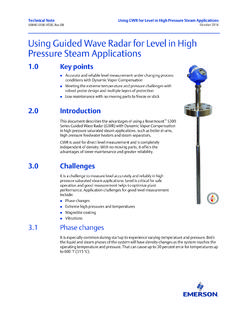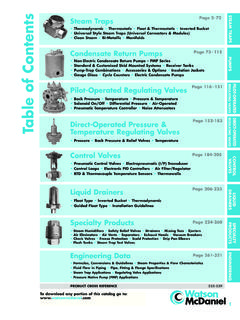Transcription of STEAM COIL SPECIFICATION - Coil Calc
1 Page 1 of 3 STEAM COIL SPECIFICATION GENERAL Non-distributing STEAM coils can be used in applications where freeze protection is not a concern. These should be used when entering air temperatures are a minimum of 40 F taking into consideration any outside air dampers being in the incorrect position. a. Provide separate supports and hangers for the coils and for the piping. b. Be certain that adequate piping flexibility is provided. Stresses resulting from expansion of closely coupled piping and coil arrangement can cause serious damage. coils having opposite end connections must be piped with expansion joints. c. Standard coils are pitched in the casings when installed for horizontal airflow. The installation should be checked to ensure that the casing is level. On vertical airflow applications , the coils must be pitched when installed. d. Do not reduce pipe size at the coil return connection. Carry return connection size through the dirt pocket, making the reduction at the branch leading to the trap.
2 E. Install vacuum breakers on all applications to prevent retaining condensate in the coil. Generally, the vacuum breaker is to be connected between the coil outlet and the return main. However, for a system with a flooded return main, the vacuum breaker should be open to the atmosphere and the trap design should allow venting of large quantities of air. f. Do not drip supply mains through the coil. g. Do not attempt to lift condensate when using modulating or on-off control. Traps a. Size traps in accordance with trap manufacturer s recommendations. Be certain that the required differential will always be available. DO NOT UNDERSIZE. b. Float and thermostatic or bucket traps are recommended for low-pressure STEAM . On high-pressure systems, bucket traps are normally recommended. The thermostatic traps should be used only for air venting. c. Bucket traps are recommended for use with on-off control only. d. Locate traps at least 12 inches below the coil return connection.
3 E. Multiple coil installation: a. Each coil or group of coils that is individually controlled must be individually trapped. b. coils in series separate traps are required for each coil, or bank of coils , in series. c. coils in parallel a single trap may generally be used but an individual trap for each coil is preferred. Controls a. With coils arranged for series airflow, a separate control is required on each bank, or coil, in the direction of airflow. b. On high-pressure installations, a two-position STEAM valve with a face and bypass arrangement is preferred where modulating control is required. c. Modulating valves must be sized properly. DO NOT UNDERSIZE. Freezing Conditions (Entering air temperatures below 35 F) a. 5JA, 8JA and 8RA coils are recommended. b. For optimum results, 10 psig STEAM must be supplied to coils at all times. c. A minimum of 5 psig is required for proper coil operation. d. STEAM distributing coils should not be used in instances where there is a high condensate load.
4 E. Modulating valves are not recommended. Control should be by means of face and bypass dampers. f. Consideration should be given to the use of two or three coils in series with two-position STEAM control valves on that coil or coils which will be handling 35 F or colder air. The desired degree of control can be attained with a modulating valve on the downstream coil. g. Provision should always be made to thoroughly mix fresh air and return air before it enters coil. Also, temperature control elements must be properly located to obtain true air mixture temperatures. h. As additional protection against freeze-up, the trap should be installed sufficiently far below coil to provide an adequate hydrostatic head to help remove of condensate during an interruption in the STEAM pressure. Estimate 3 feet for each 1 psi of trap differential required. i. On startup, admit STEAM to coil ten minutes before admitting outdoor air. Page 2 of 3 j. Provisions must be made to close fresh air dampers if STEAM supply pressure falls below minimum specified.
5 CERTIFICATION Acceptable coils are to have ARI Standard 410 certification and bear the ARI symbol. coils exceeding the scope of the manufacturer's certification and/or the range of ARI's standard rating conditions will be considered provided the manufacturer is a current member of the ARI Air-Cooling and Air-Heating coils certification program and the coils have been rated in accordance to ARI Standard 410. Manufacturer must be ISO 9002 certified. STEAM COIL DESIGN PRESSURES AND TEMPERATURES coils shall be designed to withstand 50 psi maximum operating pressures and a maximum STEAM temperature of 300 F for standard duty copper tube and header coils . Mid pressure coils (50-200 psi) shall be designed with copper tubes and cupronickel headers to withstand 400 degrees. Optional high pressure construction will include cupronickel tubes and headers to increase maximum operating pressure to 350 psi and maximum operating temperature to 450 degrees. Maximum temperatures and pressure can be obtained utilizing an all carbon steel or stainless steel construction.
6 Please call the factory for these applications . FACTORY TESTING REQUIREMENTS coils shall be submerged in water and tested with a minimum of 315 psi air pressure for standard copper tube coils . A 500 psig hydrostatic and shock test is required for high pressure cupronickel construction. coils must display a tag with the inspector's identification as proof of testing. FINS coils shall be of plate fin type construction providing uniform support for all coil tubes. Stainless steel fins shall be constructed of 304 & 316 stainless. Carbon steel fins shall be constructed of ASTM A109-83. coils are to be manufactured with die-formed aluminum, copper, stainless steel or carbon steel fins with self-spacing collars, which completely cover the entire tube surface. The fin thickness shall be +/- 5% unless otherwise specified. Manufacturer must be capable of providing self-spacing die-formed fins 4 through 14 fins/inch with a tolerance of +/- 4%. TUBING Tubing and return bends shall be constructed from UNS 12200 seamless copper conforming to ASTM B75 and ASTM B251 for standard pressure applications .
7 High pressure construction shall use seamless 90/10 Cupronickel Alloy C70600 per ASTM B111. Stainless steel tubes shall be ASTM A249. Carbon steel tubes shall be W&D - ASTM A214 & seamless - ASTM A179. Copper tube temper shall be light annealed with a maximum grain size of mm and a maximum hardness of Rockwell 65 on the 15T scale. Tubes are to be mechanically expanded to form an interference fit with the fin collars. Tubes shall have a nominal thickness of inch unless otherwise specified. FREE FLOATING CORE coils to utilize free floating core assembly to allow for thermal expansion and contraction of tubes during coil operation. CLEANING Prior to brazing, residual manufacturing oils and solid contaminants shall be removed internally and externally by completely submersing the coil in a degreaser, which is chemically compatible with the coil material. HEADERS Headers shall be constructed from UNS 12200 seamless copper conforming to ASTM B75 and ASTM B251 for standard pressure applications .
8 High-pressure construction is to incorporate seamless 90/10 Cupronickel Alloy C70600 per ASTM B111. Stainless steel will be constructed of 304L & 316L (ASTMA312) Sch-5 or Sch-10. Carbon steel headers shall be constructed from Sch-10 (ASTM-A135A) or Sch-40 (ASTM A53A) pipe. STEAM coil return headers are to be equipped with factory-installed 1/2 fpt air vent connection placed at the highest point available on face of the header. Tube-to-header holes are to be intruded inward such that the landed surface area is three times the core tube thickness to provide enhanced header to tube joint integrity. All core tubes shall evenly extend within the inside diameter of the header no more than inch. End caps shall be die-formed and installed on the inside diameter of the header such that the landed surface area is three times the Page 3 of 3 header wall thickness. CONNECTIONS Standard construction fluid connections are male pipe thread (MPT) and constructed from red brass conforming to ASTM B43 or Schedule 40 steel pipe as a minimum.
9 Stainless steel will be 304L or 316L (ASTM-A240) Sch-40 or Sch-80. Carbon steel will be A53A Sch-40, A106A Sch-40 or Sch-80 or A53B Sch-80 pipe. BRAZING High temperature filler metals shall be used for all brazed joints. Filler metal containing at least 5% silver will be used when joining the header to the core tubes. If flux has been used during the brazing process the coil must be STEAM -cleaned to remove residual fluxes from all internal and external surfaces. WELDING Gas shielded arc welding is used for welded vessels constructed of stainless steel. Gas welding is used for welded vessels constructed of carbon steel. CASING Coil casing and endplate shall be fabricated from Galvanized steel, as a standard construction, meeting ASTM and UL G90U requirements, Aluminum, thick, optional, Copper, thick, optional,16- or 14-gauge carbon steel or stainless steel, optional. double-flange casing shall be provided when coils are specified as vertical stacking.
10 Standard coil intermediate tube sheets (center tube supports) shall be fabricated from the same gauge sheet stock and material as the end plates, and to the following schedule: Finned Length (inches) Number of Tube Sheets 0 1 2 and greater 4 coils up to 120 finned length should be pitched by manufacturer in case toward condensate connection, a minimum of 1/8 per foot of finned length. coils over 120 in finned length should be pitched in field to assure proper condensate removal. DELIVERY Standard lead-time for custom made retrofit STEAM coils of standard construction with OEM circuiting shall be 11-15 working days, with reduced lead-time emergency shipment options of 10 working days and 5 working days from order placement date and based upon production approval. Standard lead-time for custom made STEAM coils of manufacturer s own standard design and circuiting shall be 10 working days, with reduced lead-time emergency shipment options for 5 working days, 48-hours and 24-hours from order placement date.






